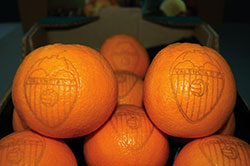Faster E. coli detection; Laser labels for produce; Tomato fiber for car parts
CUTTING EDGE TECHNOLOGY
Kansas State University researchers are helping the cattle industry save millions of dollars each year by developing earlier and accurate detection of E. coli. They have developed and validated a molecular assay that can detect and quantify major genes specific for Shiga toxin-producing E. coli O157:H7.
“Developing a method to detect E. coli before it can potentially contaminate the food supply benefits the beef industry by preventing costly recalls but also benefits the consumer by ensuring the safety of the beef supply,” said Lance Noll, master’s student in veterinary biomedical science. The newly developed test is a molecular assay, or polymerase chain reaction (PCR), that detects bacteria based on genetic sequences, which are the bacteria’s “fingerprints”. The test is rapid and less labor-intensive than existing detection methods. The method can be automated and test many samples in a short period of time.
The test can be used in a diagnostic or research laboratory to accurately detect E. coli and can help with quality control in cattle facilities. “The novelty of this test is that it targets four genes,” said T.G. Nagaraja, university distinguished professor of diagnostic medicine and pathobiology. “We are constantly working on finding better and more sensitive ways to detect these pathogens of E. coli in cattle feces.”
 CO2 laser labels fresh produce
CO2 laser labels fresh produce
Laser-marked labels for fresh fruits and vegetables will soon be on the shelves of some UK supermarkets, thanks to an agreement between leading retailer Marks & Spencer and technology company Laser Food, Valencia, Spain. The British retailer will be piloting the laser labeling system with oranges in several of its stores over the coming months. If successful, Marks & Spencer said the technology could potentially be used with other fruit and vegetable categories in the future.
“We thought it was an interesting concept to try because often fresh produce is stickered, which can be difficult to remove, plus there can be a lot of design changes, so growers can be left with stockpiles of stickers that they can’t use,” said Andrew Mellonie, Senior Agronomist at Marks & Spencer. “From this point of view, the concept would fit in with Marks & Spencer’s Plan A for sustainability.”
The technology, which offers a cost-effective, eco-friendly alternative to traditional, paper fruit labels, works by removing the pigment from a miniscule area of fruit surfaces and applying contrasting liquid, allowing producers to inscribe almost any form of logo.
Some foodstuffs develop a distinguishable mark on its surface due to the direct depigmentation action of the carbon dioxide laser beam. However, some produce do not mark easily. For those products, the EU permits the use of iron oxides and hydroxides (E 172) as a contrast enhancer, hydroxypropyl methyl cellulose (E 464) as a glazing agent, and polysorbates (E 432-436) as emulsifiers in the contrast enhancer preparation in order to improve the contrast and to allow indelible marking of certain fruits.
Tomato fiber for car parts
Ford Motor Co. and H.J. Heinz Co. are exploring the use of tomato fibers in developing sustainable, composite materials for use in vehicle manufacturing. Specifically, dried tomato skins could become the wiring brackets in a Ford vehicle or the storage bin a Ford customer uses to hold coins and other small objects.
“We are exploring whether this food processing byproduct makes sense for an automotive application,” said Ellen Lee, Plastics Research Technical Specialist for Ford. “Our goal is to develop a strong, lightweight material that meets our vehicle requirements, while at the same time reducing our overall environmental impact.”
At Heinz, researchers were looking for innovative ways to recycle and repurpose peels, stems, and seeds from the more than 2 million tons of tomatoes the company uses annually to produce its best-selling product: Heinz Ketchup. “We are delighted that the technology has been validated,” said Vidhu Nagpal, Associate Director, Packaging R&D for Heinz. “Although we are in the very early stages of research, and many questions remain, we are excited about the possibilities this could produce for both Heinz and Ford, and the advancement of sustainable 100% plant-based plastics.”
If you are working on or know of some cutting edge technology that you would like to be featured in this column, please send an email to [email protected].
